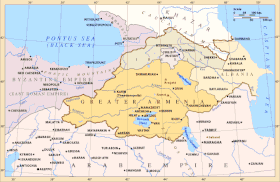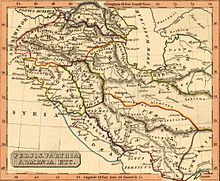| Revision as of 20:28, 5 January 2019 edit193.219.81.7 (talk) There is not any reference from Syrian and other country histories which prove that there was Great Armenia. All these places were war centre which big empires made war and in their history, they did not fight against to Great Armenia. For example, in Syrian history, there was not any reference. Even, ancient Mesopotamia and Babylon were depicted as Armenia.← Previous edit | Revision as of 00:59, 7 January 2019 edit undoNinetoyadome (talk | contribs)Extended confirmed users2,186 editsm Reverted 3 edits by 193.219.81.7 (talk) to last revision by Perryprog. (TW)Tags: Undo nowiki addedNext edit → | ||
| Line 1: | Line 1: | ||
| {{refimprove|date=March 2018}}{{for|United Armenia, a political goal of Armenian irredentists, sometimes known as "Greater Armenia"|United Armenia}} | |||
| '''There is not any reference from Syrian and other country histories which prove that there was Great Armenia. All these places were war centre which big empires made war and in their history, they did not fight against to Great Armenia. For example, in Syrian history, there was not any reference. Even, ancient Mesopotamia and Babylon were depicted as Armenia.<br><br> | |||
| {{see also|Kingdom of Armenia (antiquity)}} | |||
| ''' | |||
| 1. <br> | |||
| ] | |||
| 2. <br> | |||
| ] 9th century AD]] | |||
| 3. <br> | |||
| ] | |||
| 4. <br> | |||
| ] | |||
| 5. <br> | |||
| '''Greater Armenia''' ({{lang-hy|Մեծ Հայք}}, ''Mets Hayk<nowiki>'</nowiki>'') is the name given to the state of ] that emerged on the ] under the reign of King ] at the turn of the second century BC. The term was used to refer to Armenian kingdoms throughout the ], ], and ] periods by contemporary Armenian and non-Armenian authors alike. | |||
| Though its borders were in a constant state of flux, Greater Armenia roughly encompassed the area stretching from the ] in the west, the region of ] and parts of ] to the east, parts of the modern state of ] to the north, with its southern boundary abutting the northern tip of ]. | |||
| To the ] it was known as ''Armenia Maior'' and to the ] as {{lang|grc|Ἀρμενία Μεγάλη}} (''Armenia Megale''), to differentiate it with ] (''Pok'r Hayk′'', in Latin ''Armenia Minor'').<ref>{{hy icon}} ]. ''«Մեծ Հայք»''. ]. Yerevan: Armenian Academy of Sciences, 1981, vol. 7, pp. 434-36.</ref> It would later be used to distinguish it from the medieval kingdom that was established in ], which was sometimes referred to as Little Armenia (not to be confused with Lesser Armenia). | |||
| ==References== | |||
| {{reflist}} | |||
| ==Further reading== | |||
| *] (1970). ''Armenia in the Period of Justinian: The Political Conditions Based on the Naxarar System'', trans. Nina G. Garsoïan. Lisbon: Calouste Gulbenkian Foundation. | |||
| *] (2001). ''Armenia: A Historical Atlas''. Chicago: Chicago University Press. | |||
| ==See also== | |||
| *] | |||
| ] | |||
Revision as of 00:59, 7 January 2019
| This article needs additional citations for verification. Please help improve this article by adding citations to reliable sources. Unsourced material may be challenged and removed. Find sources: "Greater Armenia" state – news · newspapers · books · scholar · JSTOR (March 2018) (Learn how and when to remove this message) |




Greater Armenia (Template:Lang-hy, Mets Hayk') is the name given to the state of Armenia that emerged on the Armenian Highlands under the reign of King Artaxias I at the turn of the second century BC. The term was used to refer to Armenian kingdoms throughout the classical, late antique, and medieval periods by contemporary Armenian and non-Armenian authors alike.
Though its borders were in a constant state of flux, Greater Armenia roughly encompassed the area stretching from the Euphrates River in the west, the region of Artsakh and parts of Iranian Azerbaijan to the east, parts of the modern state of Georgia to the north, with its southern boundary abutting the northern tip of Mesopotamia.
To the Romans it was known as Armenia Maior and to the Greek-speaking peoples as Ἀρμενία Μεγάλη (Armenia Megale), to differentiate it with Lesser Armenia (Pok'r Hayk′, in Latin Armenia Minor). It would later be used to distinguish it from the medieval kingdom that was established in Cilicia, which was sometimes referred to as Little Armenia (not to be confused with Lesser Armenia).
References
- Template:Hy icon Yeremyan, Suren. «Մեծ Հայք». Armenian Soviet Encyclopedia. Yerevan: Armenian Academy of Sciences, 1981, vol. 7, pp. 434-36.
Further reading
- Adontz, Nicholas (1970). Armenia in the Period of Justinian: The Political Conditions Based on the Naxarar System, trans. Nina G. Garsoïan. Lisbon: Calouste Gulbenkian Foundation.
- Hewsen, Robert H. (2001). Armenia: A Historical Atlas. Chicago: Chicago University Press.